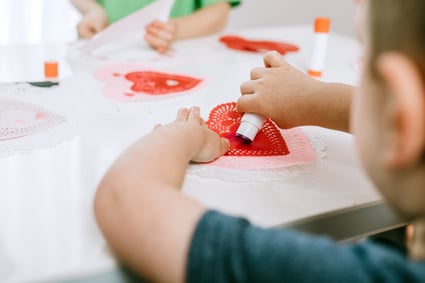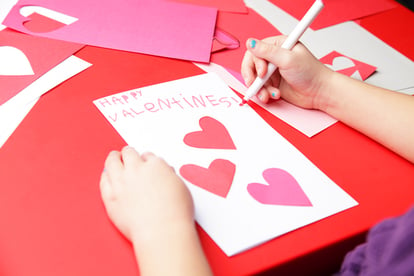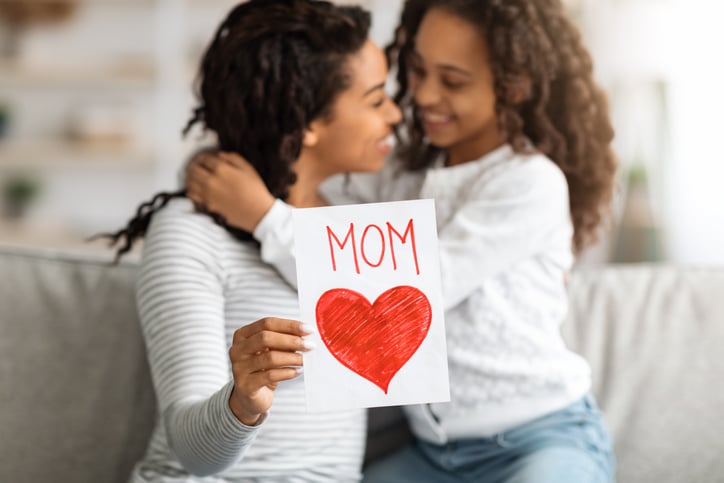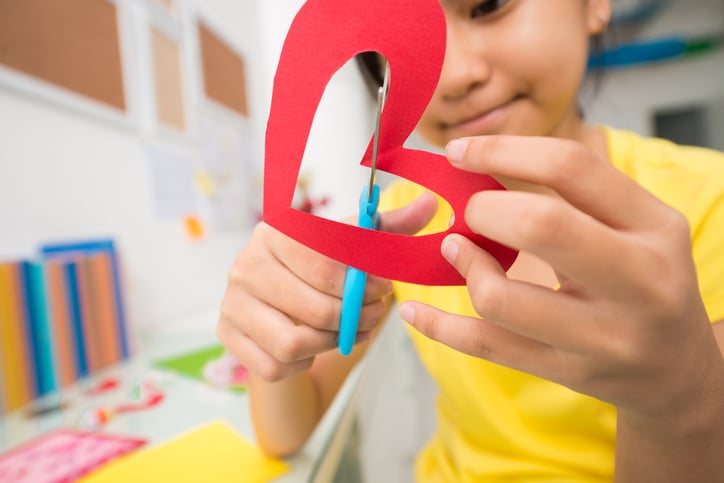Valentine’s Day and Autism: Six Ways to Help Your Child Prepare for and Enjoy the Holiday
Download Our Free Social Narrative: Giving and Getting Valentines
Valentine’s Day, the day we celebrate the people in our lives that are most important to us, is just around the corner. Many people spend time with loved ones, and kids exchange cards and treats with their teachers and classmates, but autistic children may experience the day a bit differently. While they may want to participate and enjoy the day like any other child, to them it may mean things like:
- A break from routine
- Different social norms and signals
- Unfamiliar words and phrases
- Unusual decorations and displays
- Group activities with a lot of commotion
 While it is of course impossible to avoid all of these things, these components have the potential to trigger a reaction during classroom celebrations or at other times during the day. They may want to organize their Valentines in a particular way, they may melt down when their routine is interrupted, or they may withdraw altogether to engage in a special interest or activity that helps them feel more comfortable.
While it is of course impossible to avoid all of these things, these components have the potential to trigger a reaction during classroom celebrations or at other times during the day. They may want to organize their Valentines in a particular way, they may melt down when their routine is interrupted, or they may withdraw altogether to engage in a special interest or activity that helps them feel more comfortable.
It can be sad to see autistic children struggle on Valentine’s Day, which is supposed to be a fun holiday for children and adults alike to show those around them that they are appreciated and cared about and to feel loved and valued in return. But it doesn’t have to be a sad event for them. Here are some things you can do to help your autistic child prepare for Valentine’s Day.
Six Ways to Help Your Child Prepare for and Enjoy the Holiday
1. Provide information.
Providing information about what will be happening on Valentine’s Day, even if you shared it with your child the previous year, is very important. Find out from your child’s teacher if there will be a party, what the schedule will be, and about any changes in the classroom and routine. Let your child know if there will be decorations, and what kind; if people will be wearing red or pink clothes; if the classroom furniture will be rearranged for a party; and if children will be exchanging cards and candy. Try to be as specific as possible. Start talking about this in the days leading up to Valentine’s Day, so your child has some time to process this information.
2. Write a Social Story or Social Narrative.
Many parents find it helpful to write a social story detailing what will happen at specific events and situations. For autistic children, these stories can help to build a greater social understanding of everyday circumstances by enabling them to visualize and predict their role in an event and its outcome. First developed by the therapist Carol Gray, the great thing about social stories is that anyone can learn to write one about any situation following the specific criteria she set for writing Social Stories. For a Valentine’s Day social story, the end goal could be your child giving Valentine’s cards to classmates. The story would show the significance behind this gesture and explain how other children feel when they receive these cards.
Download Our Free Social Narrative: Giving and Getting Valentines
3. Use your child’s special interests.
There is a great variety of Valentine’s cards with different themes that an autistic child can choose from based on their interest. Or, you can create your own if you cannot find a commercially produced card that depicts your child’s unique enthusiasm. Instead of it becoming extra work for them to prepare or sign cards, it can become a fun activity you can do together with them. Autistic children may be less engaged in the emotional side of Valentine’s Day, so making sure that their specific enthusiasms are considered can help them stay engaged in the different activities that take place on that day.
4. Solicit your child’s ideas.
Your child may already have an idea of what type of candy or gift they want to give to their classmates or family members based on things they’ve heard or seen leading up to the holiday. Promote independence by giving your child the chance to select the snack or gift they will give with their Valentine’s Day cards. For less-verbal children, present them with two or three choices, so they can choose by pointing, signing, or using a communication device if they use one.
5. Role-play with your child. 
Role-playing is a great way to learn by doing. It helps autistic children familiarize themselves with common social interactions and gives them the language and actions needed to engage in different activities and situations. To prepare for Valentine’s Day, if your child is open to role play, you could practice giving and receiving cards together, what to say, and how to act in each of these situations as you reverse the roles between you. Be sure to include different types of reactions, which may vary from child to child, which will help your child to stay flexible if a reaction is not exactly as practiced.
6. Talk about the meaning of Valentine’s Day.
Valentine’s Day presents quite a few abstract concepts, so it is helpful if you can discuss the meaning of Valentine’s Day with your child, and interpret some of the terminology commonly used. For example, you may want to explain that the phrase “Be My Valentine” simply means “be my friend” when cards are exchanged among classmates.

For older children, parents can explain that Valentine’s Day is a special day to show the people in our lives that we care about them. It is a perfect opportunity for parents to help children understand the importance of identifying special people in their lives such as family members, teachers, classmates, and friends. You can ask them to tell you something that they like about each person and find a mutual interest they may have with someone else.
Most of us hold sweet memories of Valentine’s Day from our childhoods. For some, their memory includes cupids, candy, and parties, while for others it’s exchanging cards with their best friends. For my autistic grandson, it is the special plush animal toy and goodie bag he’d receive each Valentine’s Day morning to start the celebration. His little giraffe was one of his favorites for a very long time.
However, while the gifts and candy are a fun bonus, the most important aspect of Valentine’s Day is that we celebrate the people in our lives that are important to us. While this holiday can present some difficulties for autistic children, it is a great opportunity to teach them to identify and learn to value the people in their lives who are special to them—and to feel loved and appreciated in return.

Ymkje Wideman-van der Laan
Ymkje Wideman-van der Laan is an author, public speaker, and Certified Autism Resource Specialist from the Netherlands. After working abroad as a teacher and humanitarian for 25 years, she moved to the US in 2006 and assumed the care of her then 6-month-old grandson, Logan. There were signs of autism at an early age, and the diagnosis became official in 2009. She has been his advocate and passionate about promoting autism awareness and acceptance ever since. Logan is the inspiration behind the Autism Is...? (tinyurl.com/5aj73ydd) series of children’s books she initially wrote for him and later published. Ymkje currently lives in California with her now 15-year-old grandson, and besides writing, presents autism training workshops for early childhood educators, parents, and caregivers. You can read more about her story in her newly released book, Autism on a Shoestring Budget, [Early] Intervention Made Easier (https://tinyurl.com/ysxhxbmf). For more information, you can visit www.autism-is.com, www.facebook.com/AutismIs, and/or contact her at autismisbooks@gmail.com.




